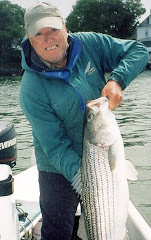Circle Hooks Required In Maine on Coastal Waters Starting in 2013
Photo
ID – Circle hooks with or without barbs are now required by law while bait
fishing on Maine
coastal waters. NOTE: Pending rule changes may allow Tub and Worm rigs to use "J" hooks. Check the law before fishing in 2013.
Striped bass 2013
fishing season in Maine begins soon and with it
a new regulation for bait fishermen. Bait fishing will now be required to use
non-offset circle hooks only while bait fishing. The new law reads as follows:
“It is unlawful to use any hook other than a circle hook when using bait. For
the purposes of this chapter the definition of circle hook means “a non-offset
hook with a point that points 90 degrees back toward the shaft of the
hook”.
The
accompanying image illustrates what is legal for Maine striped bass bait
fishing and what isn’t. Note the profile image hook point circles around to
point towards the shank of the hook. The second image shows the difference
between inline and off set hooks. Note the inline hook shows the hook point
inline with the shank. If you put the hook on a table the entire hook should lay
flat on either side to be legal. You can see that the offset hook would not lay
flat if set on a table on either side.
If you
haven’t used circle hooks to fish with, be aware there is a different way to set
the hook. It’s this simple. Let the fish run with the bait and when the line
comes taught without any effort by you, just lightly set the hook or wait for
the fish to hook itself. If you use one of those downtown hook sets from the
waters surface to over your shoulder with all the energy you can muster, you are
likely to loose every fish you encounter. The hook set method is a little
difficult to get used to until you realize it works. Usually the fish will be
hooked in the corner of the mouth with no damage done from swallowed
bait.
Fishing on
the Kennebec River above legal head of
tide is controlled by Maine’s Department of Inland
Fisheries and Wildlife which has its own freshwater regulations in place for
other species of fish as well as striped bass. There is a closed season there
for keeping stripers until July first, the same as the DMR regulations. Other
Inland rules stricter than DMR rules govern terminal tackle allowed. Check this
rule here: http://www.eregulations.com/maine/fishing/general-law-limit-information/
All other
Maine saltwater fishing
regulations can be viewed at: http://www.maine.gov/dmr/recreational/documents/2012stripedbassregs.pdf
Early season
striper fishing in Maine usually begins around
early to mid May when ocean water temperatures rise above 50 degrees Fahrenheit.
Depending on winter runoff in the mighty Kennebec River, the catch and release
striped bass fishery will be active without bait until July first. The reason
for catch and release and no bait fishing in the designated Kennebec River system is to protect
native spawning stripers until the anticipated spawn has completed.
You might
ask, is the Kennebec River actually producing its
own native stock? The answer is yes. Maine’s DMR does an annual
young of year sampling study which reveals natural production. It is not known
where and when stripers spawn as expensive studies haven’t been done to find
out. Historically, striped bass always spawned heavily in the big river until
industrial dams were built. We have had several years now with a few dams
removed, so striper production along with other indigenous fish continue to show
signs of improved development. We just don’t know how good it actually might or
could be.
Don’t forget you need a saltwater
fishing registry permit to fish in tidal waters. Go here: https://www5.informe.org/cgi-bin/online/dmr/swf/index.pl


No comments:
Post a Comment